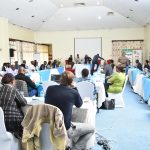Whenever many people of the mid-age generation are faced by the unprecedented contemporary climate, they normally reminisce the climate of the time they were growing up. In East Africa for example, many who grew up there will recall the predictable weather patterns where, during the March – May season, there were the heavy rains that necessitated farming for the food security of the year. In June and July, the weather was relatively cold while from August to mid-October, short rains would set in. November to January would see to what many would term as the weather abertura that is, the opening up into a warm weather ideal for vacations, before the predictable cycle continued.
Today, this is no longer the case. This year alone for example, the region has received no substantial rain. Farming has not been possible because most of it is rain-fed. The cold season that set in June is still ongoing even as we approach October. Cold weather that has never been experienced for decades has become a norm in this region with places like Elgeyo Marakwet and Nyahururu in Kenya experiencing snow for the first time in history. Food security, not to mention any vacations, has been worst hit. This has disrupted social justice and threatened the basics of human survival. Africa has been worst hit by the effects of climate change.
The paradox is that, as this generation was growing up, the climate was also changing. This generation can only explain to their children how it used to be like in the yester-years. Yet, the worst is yet to come because, even as these children are growing up, climate continues to change, this time, to the detriment of human survival. Pundits have argued that this is now the urgent time to solve the climate crisis and that this could be the last chance to address this menace.
It is however not a one-man show. The effects of climate change are too insurmountable to be addressed by one institution or individual. Climate action is a collective effort that ought to start from individuals to businesses and corporates to nations. It goes beyond reducing one’s Carbon footprint and taking more Carbon sequencing measures if we are to make the world a better place for the survival of flora and fauna. Thus, a new design of climate action is needed.
What is this new framework? Is there a one-template that fits it all? Do we need a global approach or a localized framework? These are some of the questions that we need to answer as we build this new design. Foremost, it is important to address the climate crisis through both adaptation and mitigation measures. An amalgamation of all the ideas being floated in different circles will be expedient to forestalling further climate deterioration even as human beings learn to live with the already perforated climate.
Read also: Technology has a key role in addressing climate change
Globally, nations need to renew and recommit to the several treaties that they are party to. They need to steer the drive towards restoration of natural environments, climate adaptation practices for their citizens, building climate-smart livelihoods and being inclusive by working closely with other nations and global players. If there is any healthy competition amongst nations, it should be the competition to address climate change in the respective countries. States should ensure that their citizenry are well empowered to tackle the climate crisis at an individual level.
The new design also includes bringing together all innovators and entrepreneurs to add a niche of climate action in their innovations and businesses. This calls for redesigning business delivery models to put in social impact as a dominant ideology, perhaps in the same line with profits, if not higher. If innovators and entrepreneurs and entrepreneurs took this opportunity upon them, then numerous value chains could be disrupted, for the better, and climate action could be a priority in the world. Consumers also have a major part to play in this by only opting for goods that are produced in a sustainable way.
Individually, it could also be as simple as committing to reducing their household Carbon emissions for example through upcycling and adopting green energy or tweaking one’s diet. How about spreading the word to one’s networks, sensitizing them on how you are reducing your Carbon footprint and encouraging them to do the same? Climate emergency requires robust action from all of us in order to achieve net zero greenhouse gas emissions in line with one’s country’s Nationally Determined Contributions (NDCs). While tackling the climate crisis, we also need to be wary of another paradox; That the world owes us a habitable environment for survival, but we also owe the world good conditions to make this happen.
Solomon Irungu is a Communication Consultant in Africa. He is passionate about sustainability, climate change and thriving agricultural value chains.



